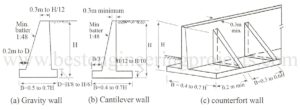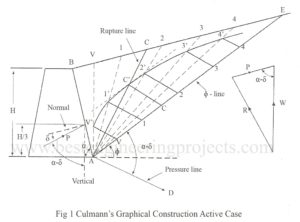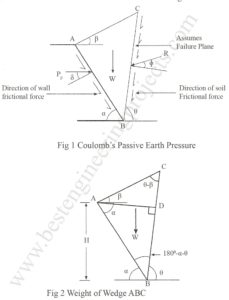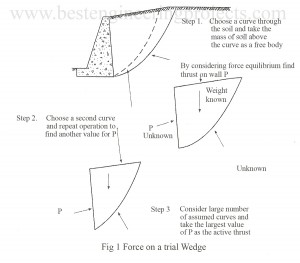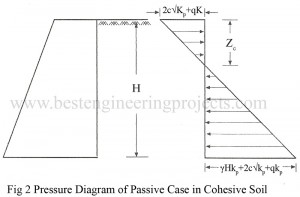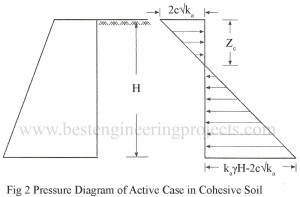What is the Stability of Different Types of Retaining Walls? Figure 1 shows gravity, cantilever, and counterfort types of retaining walls. The stability of a gravity wall is due to the self-weight of the wall and the passive resistance developed in front of the wall. The gravity walls are designed using Coulomb’s theory. Reinforced concrete walls (cantilever or counter-fort types) are more economical than gravity walls because the backfill itself provides most of the required dead load. Rankine’s theory is used to investigate the stability of reinforced concrete walls. The…
Read MoreCulmann Graphical Method for Active and Passive Case
Culmann Graphical Method for Active and Passive Case: In this method a retaining Wall is drawn to a suitable scale as shown in the Fig.1 below. The Various steps in the procedure are: Draw [late] \phi [/latex]-line AE at an angle with the horizontal. Lay off on AE distances AV, A1, A2, A3 etc to a suitable scale to represent the weight of wedges ABV, AB1, AB2, AB3, and so on. Lay off AD at an angle equal to to the line AE. The line AD is called pressure line.…
Read MoreCoulomb derivation based on limit equilibrium approach for Passive Case
Figure 1 below shows the cross section of a retaining wall. Weight of Wedge ABC From Triangle ABC, Area of Triangle ABC = Therefore: – Again, Area of Triangle of Forces for W, Pp and R From the sine rule, Substituting the value of W from the equation (3.34) into (3.35) we get, In order to get the maximum value of Pp, Where, Note: When, (leveled backfilled), (no wall friction) and (vertical interface between wall and backfill), then, . The point of application of Pp is at a…
Read MoreCoulomb’s Wedge Theory | Derivation for Active Case
Coulomb’s made the following assumptions in the development of his theory and hence it is called Coulomb’s Wedge Theory. The assumptions made by Coulomb while giving his theory was: The soil is isotropic and homogeneous. The surface of rupture is a plane. The failure wedge is a rigid body. There is friction between and the wall. Back of wall need not be vertical. Failure is two dimensional. The soil is cohesion-less. Coulomb’s equation of shear strength is valid. Coulomb made his derivation based on limit equilibrium approach. Derivation of Active…
Read MoreDerivation of Equation by Trial Wedge Method for Passive Case
In this article we will discuss about derivation of equation by trial wedge method for passive case. The equation is derived as follows. A planar failure wedge IJM is considered. There are distributed normal stresses along IJ and JM and distributed along JM. The resultants of these stresses are carried out in the analysis. In this case, the force F acts above the normal and the angle between the force F and weight W will be . The forces acting at the free body IJM are: Weight of wedge =…
Read MoreDerivation of Equation by Trial Wedge Method for Active Case
Derivation of Equation by Trial Wedge Method for Active Case: Figure 1 below shows the application of the trial Wedge method to the problem of simple retaining wall without wall friction. A planar failure wedge IJM is considered. There are distributed normal stresses along IJ and JM and distributed shear stress along JM. The resultants of these stresses are carried out in the analysis. The forces acting at the free body IJM are: let’s start the derivation of equation by trial wedge method Weight of wedge = Pa…
Read MoreTrial Wedge Method
The trial wedge method of analysis is shown in Fig.1 below. The following steps are to be followed to make the analysis. Step 1 – a mass of soil behind the wail is considered as a free body. The force P, which must exist between the free body and the wall, is found by writing the equation of equilibrium for the free body as a whole. Step 2 – a different free body is considered, having a different boundary through the soil. Once again the required force between the…
Read MoreRankine Earth Pressure in Cohesive Soil for Passive Case
In this article we will discuss about Rankine Earth Pressure for passive case. Figure 1 shows the Mohr’s circle in which point B indicates the vertical stress and point E represents the passive pressure. The wall carries a uniform surcharge q. The circle is tangent to the failure envelope. For this case the relation between Pa and is given by: ———-(1) Where, Pressure Distribution of passive case in cohesive soil Figure 2 given below shows the pressure distribution behind a wall retaining a cohesive backfill. The total resultant passive…
Read MoreRankine Earth Pressure in Cohesive Soil for Active Case
In this article we will discuss about Rankine Earth Pressure for active case. Figure 1 shows the Mohr’s circle in which point B indicates the vertical stress and point E represents the active pressure. The circle is tangent to the failure envelope. For this case the relation between Pa and is given by: ———-(1) ———-(2) Where, In the above equation (2) where z = 0 The negative sign indicates that the pressure is negative and tensile, As a result there would be gap between backfill and wall. The tensile…
Read MoreEffect of Sloping Surcharge in Passive Case
What are Effect of Sloping Surcharge in Passive Case? In previous article we had already posted Effect of Sloping Surcharge in Active Case, now in this article we are dealing with Effect of Sloping Surcharge in Passive Case. The Mohr Circle for the passive case of a retaining wall carrying a sloping backfill is shown in Fig.1. Consider an element subjected to a stress in the in the vertical direction and in the direction parallel to the backfill. As these stresses in one plane are parallel to the direction of another…
Read More